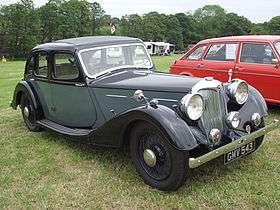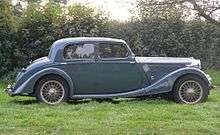Riley 16
| 1938 Riley 16hp | |
|---|---|
 Kestrel 16hp 6-light saloon first registered January 1938 | |
| Overview | |
| Manufacturer | Riley |
| Production | 1939-1940 |
| Body and chassis | |
| Body style |
|
| Powertrain | |
| Engine | 2.4 L Straight-4 |
| Dimensions | |
| Wheelbase | 116 in (2,946 mm)[1] |
| Length | 179 in (4,547 mm) |
| Width | 63 in (1,600 mm) |
| Chronology | |
| Predecessor | none |
| Successor | Riley RMB |
The Riley 16 hp is a car made by the British Riley company from 1937 to 1940. It slotted into Riley's range immediately below their 18 hp V8 model. Announced in September 1937 for the Earls Court Motor Show[2] it became one of the two genuine Riley models in the rationalised range that followed the 1938 takeover by the Nuffield Organization.
It had a 2443cc straight-four engine with twin cams and S.U carburettor which developed 82 bhp. The transmission was a four speed manual. It was capable of a top speed of around 80 mph.[1] The chassis was a lengthened version of the one used on the Riley 12 hp which was introduced at the same time.
The 1939/40 16 hp was available with a standard saloon, Kestrel fastback saloon or drophead coupe coachwork.[3]
 Continental sports saloon (this body is on a 12/4 chassis) |
 Adelphi 6-light saloon (this body is on a 15/6 chassis) |
_(18562893249).jpg) Kestrel 16hp 6-light saloon |
.jpg) Adelphi 16hp 6-light saloon |
| Riley 2½-litre Big Four | |
|---|---|
| Overview | |
| Manufacturer | Riley Motors Limited |
| Also called | Riley 16 h.p.[4] |
| Production | 1937 to 1957[5] |
| Combustion chamber | |
| Configuration | straight four |
| Displacement | 2.443 L (149.1 cu in)[5] |
| Cylinder bore | 80.5 mm (3.17 in)[2] |
| Piston stroke | 120 mm (4.7 in)[2] |
| Cylinder block alloy | cast iron, aluminium sump, alloy pistons |
| Cylinder head alloy | cast iron, hemispherical combustion chambers, spark plugs in centre between valve covers[4] |
| Valvetrain | 90-degree angled overhead valves[5] operated by twin high-lift camshafts moving rockers with short light stiff push-rods powered from the crankshaft by duplex roller chains[4] |
| Compression ratio | 6.9 : 1[5] |
| Combustion | |
| Fuel system | Twin H4 SU carburettors[5] mechanical petrol pump[4] |
| Fuel type | petrol |
| Oil system | pressure fed from sump by submerged gear-type pump driven by skew gear from camshaft |
| Cooling system | water, thermostatically controlled flow, belt-driven water pump and radiator fan[4] |
| Output | |
| Power output |
106 bhp @ 4,500 rpm Tax rating 16hp[5] |
| Chronology | |
| Predecessor | none before 1937 |
| Successor | Riley RMH then BMC C-Series engine |
Michael Sedgwick described this long-stroke four as a first-class tourer in the Riley tradition, Britain's largest four since the 4½-lire Bentley ended production in 1931. Its chassis he said was regular Riley - beam axles and Girling brakes - fitted with Borg-Warner overdrive as standard it would run up to 90 mph. The engine ran very smoothly for a four-cylinder. Good value for money it survived into Riley's Nuffield-owned era but with disc wheels, umbrella handbrake lever and ordinary synchromesh gearboxes, (Nuffield) ". . . made a few wire-wheeled Kestrels in 1939 and 1940 to keep the traditionalists happy".[6]
References
- 1 2 Culshaw; Horrobin (1974). Complete Catalogue of British Cars. London: Macmillan. ISBN 0-333-16689-2.
- 1 2 3 Cars Of 1938. Riley Models. The Times, Friday, Sep 17, 1937; pg. 6; Issue 47792
- ↑ Sedgwick, M; Gillies (1989). A–Z of cars of the 1930s. UK: Bay View Books. ISBN 1-870979-38-9.
- 1 2 3 4 5 Cars of To-Day. '’’The Times'’, Tuesday, 16 March 1937; pg. 22; Issue 47634.
- 1 2 3 4 5 6 Rileyrob. "Healey Silverstone (1949–51)". Retrieved 31 January 2014.
- ↑ Michael Sedgwick, Cars of the 1930s, B T Batsford, London. 1970 ISBN 0713404655